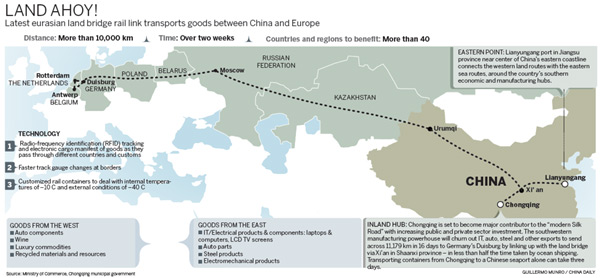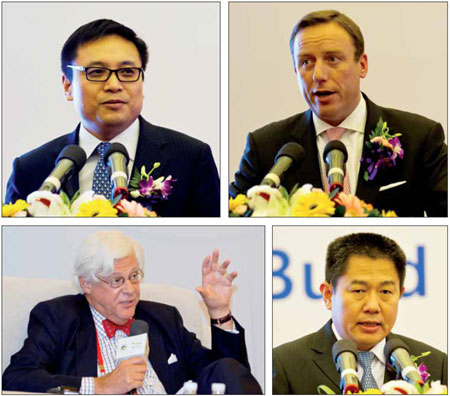On track
Updated: 2012-06-08 10:40
By Alexis Hooi and Ma Wei (China Daily)
|
|||||||||||
Jens Ruebbert, senior vice-president of the European Union Chamber of Commerce in China and managing director and chief administrative officer of Deutsche Bank (China), says the chamber is well aware of Chongqing's growth and it is "quite committed" to opening its next office in the megacity.
"There is no doubt about it. EU-China economic relations are hugely important. In 2011, the EU-China trade relationship was the second largest in the world. In 2012, it is expected to become the largest in the world," says Ruebbert, whose chamber now has more than 1,700 members split into 42 working groups with seven local chapters in China.
"The EU and China have both recently issued medium-term development strategies and these two strategies are very similar. The core of both the EU's 2020 strategy and China's 12th Five-Year Plan is the guide for green and sustainable growth based on innovative products. China aims to rebalance its economy through increasing domestic consumption and opening its economy further. This process will bring the economies of China and the EU closer.
"The EU offers great opportunities for China and for increasing cooperation. In a time of continued debt crisis in Europe, China has indeed opportunities to increase its investment in Europe. The European chamber is a proponent of open markets and welcomes and encourages such investment."
The Chinese government's "go west" policy to spur investment inland also bodes well for EU companies that are making their presence felt in Chongqing, Ruebbert says.
"It absolutely creates opportunities for EU companies. This Eurasian railway is really very efficient. We have heard it takes less than about 16 days, it is less than half the shipping speeds with convenient customs passing and integrated operating platforms. It will also serve to further enhance the economic and trade ties between China and Europe, and to attract investment to Chongqing. It shows the logistics development of Chongqing and offers opportunities for further European cooperation. The railway is another example of the strong competitive advantages of Chongqing and contributes to efficiency to infrastructure."
Fudan University's Shen points out that the Chongqing connection in the Eurasian Land Bridge can help transfer foreign investment to western China, significantly increasing the export capacity of the megacity.
"In recent years, Chongqing has been promoting the production capacity of notebook computers to reach 1 million units annually, which is the sum of six coastal provinces. This strategy itself is a major boost to the economic boom of Chongqing and the central regions," Shen says.
Mu Huaping, director of Chongqing's Municipal Commission of Economy and Information Technology and head of the Municipal Logistics Office, says when the authorities discussed the latest rail link two years ago, they were still not confident of the project. But it has taken just that time for them to be convinced of the numerous benefits of the connection and the role it will play in cross-border trade.
|
Clockwise from top left: Mu Huaping, director of the Chongqing Economic and Information Technology Commission; Jens Ruebbert, senior vice-president of the EU Chamber of Commerce in China; Zhai Qian, deputy director general of the European Department at the Ministry of Commerce; and Jochum Haakma, chairman of the Netherlands Council for Trade Promotion. Xie Songxin / China Daily |
"Chongqing's auto and electronics products are seeing strong growth. Of these, the low-end variety heads to Shenzhen before being transported by ship to Western markets, while more high-end products are delivered by air. We started exploring the land bridge as an alternative to these routes," Mu says.
 |
But he says there are many issues that still need to be resolved before the bridge can be operated optimally. These include different track gauges between countries like Russia along the route, the limited storage capacity of train containers when compared to those used on ships, time-consuming land border checks and extreme temperature and environmental conditions as the trains wind through Central Asia and Eastern Europe, all of which make the cost of using the land bridge significantly higher than maritime shipping.
"Stakeholders on both sides in the West and China as well as those along the route need to work together to iron out these issues to get the land bridge rolling. We are now providing the necessary platforms for these to happen," Mu says.
To that effect, a logistics company is also being set up to serve as a platform for the rail link co-funded by the Chinese, Kazakhstan, Russian and German railway authorities.
"Lowering the cost will be the major factor in making this land bridge more competitive, especially when many Chinese exports headed to the West are extremely sensitive to price differences. These are naturally the top concerns for businesses that choose the land bridge over other forms of shipping."
Similarly, He Mingke, vice-president of the China Society of Logistics, points out that the land bridge traverses six different countries, all with political, economic and environmental conditions that could pose major obstacles to the smooth running of the railway.
"The success of the land bridge will ultimately depend on factors including a concerted political will and coordination of technology and operational systems for businesses to become confident enough to use it."
But Claudio Facchin, senior vice-president of Swedish-Swiss power and automation technology giant ABB Group and president of its North Asia Region, says European companies such as his are already taking advantage of Chongqing's efforts to play a central role in China-EU trade via new channels such as the land bridge.
"We see the particular importance of being here in the western region, particularly in Chongqing. It has been growing at almost double the speed of the country, which we all know is the largest growing market."
Facchin's confidence in the growth of the region and the logistics advantages of the megacity follow those by various industry leaders including IT giants Acer and Hewlett-Packard.
Automakers have also been quick to move, with Ford China investing in at least three factories inland. Germany's largest steelmaker ThyssenKrupp has also said it was planning an assembly shop, painting workshop and quality-control laboratory in the region to help provide parts for major automakers.
Similar to the aims of the new land bridge, all are placing high bets on the Chinese economic engine to sustain development in both East and West.
At the Liangjiang forum, Jochum Haakma, chairman of the Netherlands Council for Trade Promotion, cited a Chinese saying of an auspicious purple cloud being blown from the east, to allude to the help that the Chinese economy will give to its beleaguered counterpart in the West.
"We have seen from all this that China is in relatively very good shape while the European Union is anything but. So whenever this purple cloud appears again in the East, in China, you should send it straight to the West to help us."
Contact the writers at alexishooi@chinadaily.com.cn and mawei@chinadaily.com.cn

Today's Top News
Rescuers race against time for quake victims
Telecom workers restore links
Coal mine blast kills 18 in Jilin
Intl scholarship puts China on the map
More bird flu patients discharged
Gold loses sheen, but still a safe bet
US 'turns blind eye to human rights'
Telecom workers restore links
Hot Topics
Lunar probe , China growth forecasts, Emission rules get tougher, China seen through 'colored lens', International board,
Editor's Picks

|

|

|

|

|

|






